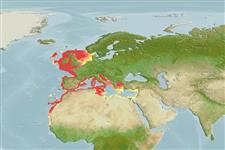Actinoptérygiens (poissons à nageoires rayonnées) >
Pleuronectiformes (Flatfishes) >
Soleidae (Soles)
Etymology: Microchirus: Greek, mikros = small + Greek, cheir = hand (Ref. 45335).
Environnement / Climat / Gamme
Écologie
; marin démersal; profondeur 20 - 400 m (Ref. 35388). Subtropical, preferred 21°C (Ref. 107945); 60°N - 15°N, 18°W - 36°E
Northeast Atlantic: British Isles south to Senegal (baie du Lévrier) and the Mediterranean.
Length at first maturity / Taille / Poids / Âge
Maturity: Lm ?, range 14 - ? cm
Max length : 35.0 cm SL mâle / non sexé; (Ref. 35388); common length : 14.0 cm TL mâle / non sexé; (Ref. 3397); âge max. reporté: 14 années (Ref. 32766)
Épines dorsales (Total): 0; Rayons mous dorsaux (Total): 0. Upper eye less than its own diameter from dorsal profile of head. Anterior nostril on blind side not enlarged, its distance from front margin of head about twice in its distance from cleft of mouth. Anterior nostril on eyed side with backward-pointing tube reaching to front border of lower eye. Pectoral fin on eyed-side small, on blind side reduced.
Inhabits mud or sand bottoms. Feeds on a wide range of small bottom-living organisms, mainly crustaceans (amphipods, shrimps), also polychaete worms and bivalve mollusks (Ref. 4710). Utilized as a food fish.
Robins, C.R., R.M. Bailey, C.E. Bond, J.R. Brooker, E.A. Lachner, R.N. Lea and W.B. Scott, 1991. World fishes important to North Americans. Exclusive of species from the continental waters of the United States and Canada. Am. Fish. Soc. Spec. Publ. (21):243 p. (Ref. 4537)
Statut dans la liste rouge de l'IUCN (Ref. 115185)
CITES (Ref. 94142)
Not Evaluated
Menace pour l'homme
Harmless
Utilisations par l'homme
Pêcheries: commercial
Plus d'informations
RéférencesAquacultureProfil d'aquacultureSouchesGénétiqueFréquences alléliquesHéritabilitéPathologiesTraitementMass conversion
Outils
Articles particuliers
Télécharger en XML
Sources Internet
